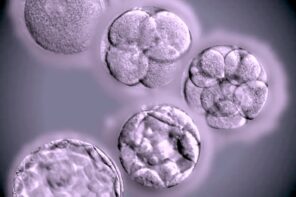Sound the alarm! All hands to your rosaries, for the true faith has finally gone too far! The Pope is planning to fund science!
That’s the worry, at least, that drives the plot of Dan Brown’s 2000 novel Angels & Demons, the film version of which was released in mid-May. Angels & Demons is the successor to 2006’s The Da Vinci Code, which its star Tom Hanks called “just a good story loaded with hooey and nonsense.” Of course, he only has to say that because it’s not true.
Everybody knows that despite getting most of his facts wrong, Dan Brown is American culture’s preeminent religious thinker and, in particular, our most trusted interpreter of Catholicism. Even though the Vatican decided to play it cool and say the movie is okay, the New York Times’ novice conservative pundit Ross Douthat took it as an occasion to rail against theological liberalism. And now I’m going to treat it as a barometer for the peculiar state of religion-and-science these days.
Here’s what happens (plot spoiler alert). In the basement of CERN, a secret laboratory run by a brilliant “theo-physicist” (as he calls himself in the book) and his “bio-entanglement physicist”/Italian-supermodel adopted daughter, manages to harvest the fruits of the Large Hadron Collider and to generate a couple of tiny pellets of antimatter. If you remember your Star Trek, you know this is the highly unstable anti-substance that makes the Enterprise go fast and photon torpedoes go boom.
While the do-gooding supermodel is mostly interested in creating a green energy source, theo-physicist wants to recreate the conditions of Genesis and show that matter (all creation) could’ve come from pure energy (God). The experiment works, and antimatter comes out. Everyone’s gratified. But, moments later, theo-physicist is murdered, a pellet of antimatter gets stolen, and Vatican City is set to blow up at midnight. Oh, and all the Cardinals are huddled there in a conclave to elect the new Pope (except for the four favorites, who are being executed in dramatic fashion). The Church is doomed. Were it not, that is, for Harvard “symbologist” Robert Landgon and his ingenious puzzle-solving. (Perhaps the world would be safer if his field of research actually existed.)
What’s the motive for this unthinkable terrorism? Ostensibly it’s the fruit of a centuries-old feud between the dogmatic Vatican and a radicalized remnant of the Illuminati, the brotherhood (or, as the book calls them, the “think tank”) of benevolent scientists whom the aforementioned religion cruelly repressed, and whose actual importance Brown greatly exaggerates. All this provides an occasion for a handful of discourses on the errors of both a stultifying religion and a science that’s tone-deaf to morality. The pious in this tale rant against this new god of science, while Langdon’s scholarly monotone declares that the Church has always stood square in the way of progress, whether by imprisoning Galileo for heresy or opposing stem-cell research. The speeches, which usually happen at the most inappropriate times and places, are merely the tip of the iceberg from the pages-long monologues in Brown’s book.
But then there’s a giant plot twist. The Illuminati, we learn, are extinct after all. Their resurrection was the invention of a zealous priest who was appalled that his Pope had shown interest in the theo-physicist’s experiment. Apparently forgetting that the Church has supported scientific research for centuries (including Galileo’s, in fact), he couldn’t bear that it would fund the Genesis-making experiments at CERN. When science explains away the hand of God, he believes, religion will lose its relevance. People will doom themselves to spiritless squalor. Ewan McGregor portrays, to my knowledge, the first action-movie villain driven to his diabolical acts by an addiction to intelligent design theory.
Natural Enemies
There aren’t a lot of religion-and-science movies, and even fewer great ones. Near the top of anybody’s list, though, would have to be Inherit the Wind, the 1960 film of a 1955 play based on the 1925 Scopes monkey trial in Dayton, Tennessee. In it, stand-ins for William Jennings Bryan and Clarence Darrow match wits over the fate of Darwinism in public schools. One man stands for science and reason, the other for old-time religion. Sure, there are subtleties and gray areas, but basically, that’s how the world works. Religion and science are natural enemies. As civilization matures into its reason, therefore, it grows out of its religions. Inherit the Wind captures this process in all its triumph and inevitable tragedy.
Angels & Demons caricatures the traditional position well, though with a fraction of the grace. Says a scientist in the book who didn’t quite make it to the movie:
Mr. Langdon, all questions were once spiritual. Since the beginning of time, spirituality and religion have been called on to fill in the gaps that science did not understand… Soon all Gods will be proven to be false idols. Science has now provided answers to almost every question man can ask.
But, one soon learns, this arrogance is supposed to be as false as the Church’s enforced ignorance. Dan Brown’s favorites are both dead: the theo-physicist and his papal patron, both fatherly, spiritual old men whose ultimate faith was that science and religion (Christian religion, at least) lead, in a hit-you-over-the-head-with-God sort of way, to precisely the same place.
In this, Brown is a true believer. “In many ways I see science and religion as the same thing,” he says in an interview on his Web site. “Both are manifestations of man’s quest to understand the divine.” If both are left free to operate, free from intellectual arrogance and dogma, they will spiral into mutual completion. Not even harmony in separate-but-equal spheres. No, they’ll correct each other, benefit each other, and we’ll all be the better for it.
This kind of thinking has a history. It’s little different from the religious flavor of the European Enlightenment; figures like Isaac Newton and, more soberly, Thomas Jefferson. Much of 19th-century Anglophone theology stood in awe of what zoology could teach about God’s creation. Until Darwin. Since The Origin of Species appeared in 1859, there’s been little use hoping for convergence. Europe has fallen for secular scientism, and the United States for semi-closeted creationism. The best one can expect is a habitable truce. So where is Dan Brown’s confidence coming from?
Deep in the American psyche, it turns out. Since colonial times there has been a gnostic strain running through our religious imagination, one that could embrace a revolution led by Freemasons and uncover new scriptures written on secret golden plates. Free from the burden of Europe’s institutional rivalries, it has always refused to see scientific reason as a threat to faith. In the 19th century, it gave birth to “metaphysical” movements like Christian Science and spiritualism, which staked a claim to science convincing enough to attract the interest of some leading scientists. The strain continues in the New Age movement’s excitement for quantum physics.
Today, perhaps its most important expression comes in the form of the John Templeton Foundation, established in 1987 with the fortune of a big-thinking Presbyterian investor who had been deeply influenced by metaphysical religion. Last year, Templeton gave away more than $70 million for research at the confluence of science and spirituality.
This money has helped to foster a strenuous mood in spiritually-inclined science. Studies and conferences now proliferate about the health benefits of religion, the biological bases of the Golden Rule, and the physics of immortality. Even the Vatican has gotten on board. At a Templeton-funded conference on evolution at the Pontifical Gregorian University in Rome this year, leading evolutionary biologists took center stage; a representative from the Turkish creationist movement led by Harun Yahya was forcibly removed from the microphone. With his eye on the secularism that has engulfed Europe, Pope Benedict hopes that the roads of science can lead back to Rome.
The Vatican might agree with Dan Brown in this respect more than it would like to admit. By allying with Templeton, the Church has begun (or, rather, continued) to embrace what Brown’s zealous priest-villain fears most of all: “spiritually-based scientific research.” In the book, he thinks to himself:
Madness! The church investing in research that threatened to make the church obsolete? Work that spawned weapons of mass destruction? The bomb that had killed his mother… [Long story.]
It is true, there is a deal with the devil in every alliance with science. She is a tricky mistress. But so is faith. Both have a way of being inflexible.
The zealot’s zeal drives him to a beautiful performance near the end of the film. Still not revealed as a villain, he arranges it so that the antimatter detonates in an airburst high above St. Peter’s Square, with thousands of people below. The zealot comes parachuting down from it, having saved the Vatican from incineration. The crowd cheers for him, and he seems poised to become the next Pope. My heart leapt, it really did, for science (in the glorious fireball) and for the loveliness of the Catholic faith (in the falling angel).
In the end, though, it’s a sham. His villainous ways are revealed, he immolates himself in St. Peter’s, and yet another old dullard gets elected Pope. According to the book, antimatter is soon to be bought up and wildly exploited by greedy corporations. It’s the cycle of boom and bust—glitzy promise, then the betrayal of the mundane, or worse—that comes with melodramatic hopes, whether they are religious, scientific, or some combination thereof. It is against this that the assurance of Dan Brown’s gnosticism comes in so much handy: rest assured the thrilling truth is out there somewhere, even if you have to be a symbologist or a theo-physicist to uncover it.
Then again, things do start making more sense when you put aside melodrama and bother to get the facts right. Facts often fall short of thrilling, but they can be quite interesting anyway.




